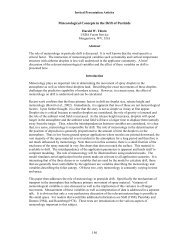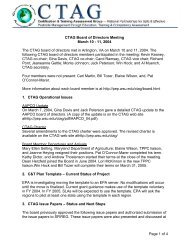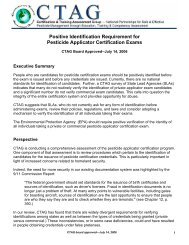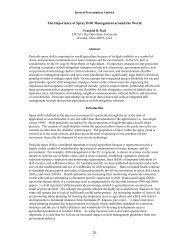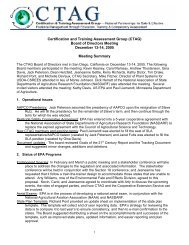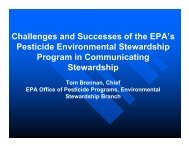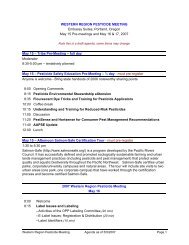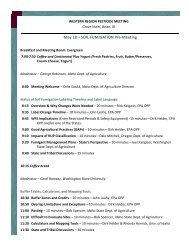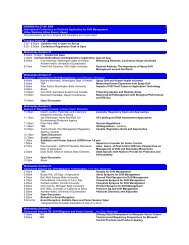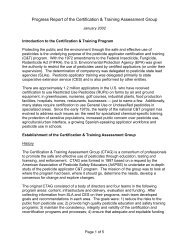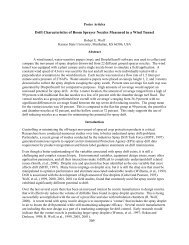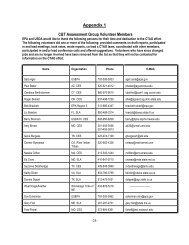Kousa Dogwoods that Resist Disease
Kousa Dogwoods that Resist Disease
Kousa Dogwoods that Resist Disease
You also want an ePaper? Increase the reach of your titles
YUMPU automatically turns print PDFs into web optimized ePapers that Google loves.
<strong>Dogwoods</strong><br />
for<br />
Pacific Northwest Gardens<br />
A S u r v e y o f S e l e c t e d K o u s a D o g w o o d V a r i e t i e s<br />
by Ralph Byther<br />
Professor Emeritus, Plant Pathology<br />
<strong>Kousa</strong> dogwoods (Cornus kousa)—also<br />
referred to as Korean, Chinese, or<br />
Japanese dogwood—can be planted as<br />
ornamental trees in the Pacific Northwest.<br />
There are many varieties available which<br />
exhibit a wide range of horticultural characteristics.<br />
Flower bracts (upper left) may be<br />
snowy white, cream-colored, or even light<br />
pink or deep rose in color. They bloom over<br />
an extended period in late spring and<br />
early summer, prefer full sun exposure, and<br />
many also provide consistent and striking<br />
fall color (lower left). Some varieties produce<br />
abundant, colorful fall fruit (upper right)—which<br />
can be useful as a food source for wildlife.<br />
Perhaps their greatest advantage, however,<br />
lies in their resistance to dogwood anthracnose<br />
(lower right)—a fungal disease which can<br />
cause unsightly leaf and bract damage,<br />
defoliation, and even death to both western<br />
and eastern native dogwoods.
Selected Varieties of<br />
<strong>Kousa</strong> Dogwood<br />
Beni Fuji<br />
‘Beni Fuji’ produces an abundance of smaller pink<br />
flower bracts on a slower-growing, spreading tree<br />
form. It demonstrated very good resistance to<br />
anthracnose, good fall color, and abundant fruit<br />
production.<br />
Dwarf Pink<br />
‘Dwarf Pink’ is a moderately slow-growing, spreading<br />
tree with light pink flower bracts; the color is<br />
more intense at the bracts’ outer margins. It showed<br />
very good fall color and fruit production. This variety<br />
had an acceptable level of resistance to anthracnose.<br />
China Girl<br />
‘China Girl’ is a fast-growing tree having an abundance<br />
of large white flower bracts. It characteristically<br />
showed very good anthracnose resistance<br />
and fall color, but had limited fruit production.<br />
Ed Mezitt<br />
‘Ed Mezitt’ has a moderate growth rate with unique<br />
purple- to bronze-colored leaves, which contrast<br />
with the showy white flower bracts. It demonstrated<br />
excellent anthracnose resistance and fall color,<br />
with somewhat limited fruit production.
Moonbeam<br />
‘Moonbeam’ is a fairly vigorous tree having large<br />
white flower bracts. It demonstrated acceptable<br />
anthracnose resistance and very good fall color.<br />
Fruit production is very limited.<br />
Summer Majesty<br />
‘Summer Majesty’ is a moderately fast growing tree<br />
producing large banks of medium-size white flower<br />
bracts over an extended bloom period. It demonstrated<br />
good anthracnose resistance, but poor fall<br />
color and only limited fruit production.<br />
Satomi<br />
‘Satomi’ produces abundant medium pink flower<br />
bracts on a vigorous tree. It showed excellent fall<br />
color, acceptable anthracnose resistance and<br />
limited fruit production.<br />
Wilton<br />
‘Wilton’ is a slower growing white-bracted tree.<br />
Flower bracts hold on the tree for longer than<br />
normal and often have a pinkish tone as they age.<br />
It demonstrated good anthracnose resistance and<br />
fall color while having moderate fruit production.
Cultivars Evaluated at WSU Puyallup<br />
Cornus nuttallii<br />
Baby Splash<br />
Beni Fuji<br />
Big Apple<br />
Blue Shadow<br />
China Girl<br />
Chinensis<br />
Constellation *<br />
Dwarf Pink<br />
Ed Mezitt<br />
Emerald Star<br />
Gold Cup<br />
Gold Star<br />
Highland<br />
Lance Leaf<br />
Lustgarten Weep<br />
Milky Way<br />
Milky Way Select<br />
Moonbeam<br />
National<br />
Porlock **<br />
Red Ryan<br />
Rosabella<br />
Ruth Ellen *<br />
Satomi<br />
Silver Cup<br />
Snow Flake<br />
Speciosa<br />
Square Dance<br />
Stellar Pink *<br />
Summer Majesty<br />
Trinity Star<br />
Tsukabo-no-nine<br />
Twinkle<br />
Wilton<br />
* Hybrid C. kousa × C. florida<br />
** Hybrid C. kousa × C. capitata<br />
Anthracnose<br />
<strong>Resist</strong>ance<br />
Annual<br />
Growth<br />
Fall<br />
Color<br />
Fruit<br />
Production<br />
Note: A single bar represents a low rating in its category compared to other varieties listed (e.g. less disease resistance,<br />
slower growth, poor fall color, limited fruit production). Additional bars indicate a greater strength of the attribute.<br />
WSU Extension programs and employment are available to all without discrimination.<br />
Evidence of noncompliance may be reported through your local WSU Extension office.



